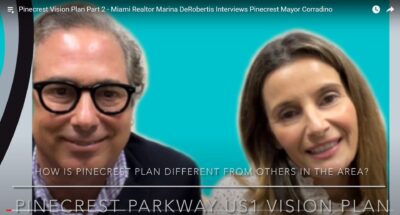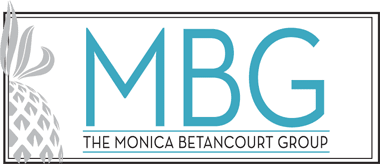{Reading Time: 5 minutes}
The affluent Village of Pinecrest has been a cherished, welcoming community since the 1960s, and has evolved into one of the most coveted of Miami’s best neighborhoods. In October 2021, the Pinecrest Parkway US1 Vision Plan (originally developed in 2012) was revisited and updated.
As the revitalization project takes shape, some residents have questions about how it will impact their neighborhood and the overall aesthetic of the Village of Pinecrest. Marina DeRobertis, a Realtor with The Monica Betancourt Group, spent some time with Mayor Joseph Corradino to discuss topics such as zoning, home values, and what residents can expect as the plan rolls out.

Introduction to the Pinecrest Parkway Vision Plan
Marina: I’m Marina DeRobertis with The Monica Betancourt Group at BHHS EWM Realty. I’m here with Mr. Joseph Corradino, the Mayor of the Village of Pinecrest, for a session of questions and answers about the Pinecrest Parkway US1 Vision Plan. Mr. Corradino, thank you for opening this space to answer questions and clarify more about the Pinecrest Parkway Vision Plan. Before we start with the questions and answers, can you please give us a quick overview about the project and what it is?
Mayor Corradino: Yes, absolutely. Thank you for having me, I really appreciate it. We’re upgrading our US1 Vision Plan. It was originally done in 2012, and it’s been very successful. In the previous 10 years since we’ve done it, we’ve talked about a lot of things that we need to aspire to in Pinecrest — diversifying our housing stock, making sure that the young folks can move into the neighborhood, and those that want to get out of their acres and half-acres have somewhere to go without leaving the neighborhood. Also, making a better visual experience for the corridor, and providing a better shopping and dining experience for our citizens. The very last reason is that there’s a $300 million investment in rapid transit that we would be able to support, as well, which is our responsibility.
How Is Population Density Control Approached in the Pinecrest Vision Plan?
Marina: Residents may be worried about the increase in population density in our village and how this could change the character of the Village of Pinecrest. This could impact the values of our homes. Can you please help us understand how the Village is working to prevent this from happening?
Mayor Corradino: Yeah, absolutely. When we talk about land, land has two things when it comes to zoning and land use: it’s got a density and it’s got an intensity. And what we’re doing here is really simply tinkering with the ratio of each. Right now, it’s got 100% intensity. That’s commercial space. Density is population. We’re going to try to better balance density and intensity. The good thing about that is, commercial intensity is much more impactful on traffic than residential intensity. So, as we put residential into the neighborhood, the amount of trips and the amount of traffic congestion would go down. The traffic from commercial is about twice as much as it is from residential. Relative to property values, this will only have a positive impact on property values. Property values tend to go up around rapid transit stations. That’s not only well-known nationally, but if you take our own example at Dadeland, that was done at about the same time Pinecrest had incorporated, and the property values there have gone up faster than the property values of surrounding neighborhoods, so it would have a positive impact on property values.
Marina: Very good news, great to hear that.
Mayor Corradino: Excellent news, it’s a great investment.
Marina: Thank you.
Are There High-Rise Buildings in Pinecrest’s Future?
Marina: We have seen a transformation of several cities along the US1 Corridor, and residents may be wondering if similar changes would be taking place in the Village of Pinecrest. Can you explain how the Pinecrest Parkway US1 Vision Plan is different from other areas where we have watched multiple-storied buildings be constructed?
Mayor Corradino: Yeah, absolutely. The wonderful thing about being in a city is you get control of your land use and zoning, and the success of Pinecrest has been we’ve always done our planning. We’ve always been ahead of the problems, and this is no different. This is our project. We don’t want to be Coral Gables, we don’t want to be Miami-Dade County. We’re a less dense… we’re a lower-scale community, so we’re not talking about high-rise buildings, we’re not talking about those types of 16- and 20-story buildings. We’re really keeping it low, at 6 stories or less. And that’s usually had a positive effect for us.
Which Pinecrest Areas Are included in the Vision Plan?
Marina: That’s very great news. Just as a follow-up, do we have specific areas where this project will be happening?
Mayor Corradino: Yes, absolutely. This isn’t corridor-wide. We’re looking at the corridor, but we’ve right now got basically three different areas where it’s happening, one of which already exists in North Pinecrest across from Dadeland. We’ll be updating that area, the area and the commercial area around 104th, and the commercial area around 136th Street. The issue is that we want to make sure that this type of planning and development doesn’t spill into the residential areas. It’s pushing the residential into the commercial, confining it on the commercial corridor, and thereby protecting the residential… the single-family residential character of our neighborhoods.
Marina: I’m delighted to hear that, and to know that the residential area in our city will be protected by this project in a very proactive way.
Mayor Corradino: Yes and that’s something that we can only accomplish through a planning exercise like this. You know, the county comes in every so many years and draws a circle or some lines around where they want to put the population, and it’s always on top of our single-family neighborhoods. This ends that conversation once and for all. It will never be on top of our single-family neighborhoods. This protects the character of our single-family neighborhoods 100%.
Marina: Thank you for the clarification.
Mayor Corradino: You’re welcome.
The Vision Plan protects the character of our single-family neighborhoods 100%.
What Is the Timeline for the Pinecrest Parkway US1 Vision Plan?
Marina: What is the timeline for this transformation to happen, and when should residents start to see change around our area?
Mayor Corradino: We don’t really have a timeline. Pinecrest is about quality, not quantity. We started this process in January of 2021, and we’ve slowed it down. And so we’ll do it until we’ve got all the input we need from people. The only change you’ll see from this is potentially new comprehensive plan language and new zoning code language. The Village isn’t a developer, so we don’t build any of the buildings. This will happen at the pace of the market and, if you look at it, the areas that we changed on this very same scale in 2004, nothing has been built there. So, it will take time. This is a vision that will be implemented over 10, 20, and 30 years.
How Can I Get Involved in this Pinecrest Vision Plan?
Marina: How can residents get more involved with the Pinecrest Vision Plan, and share thoughts and concerns that they may have around this project?
Mayor Corradino: We have been very successful in the past with our Inspire Pinecrest campaign, and this will follow that same format. As we get deeper into this, we’ll be setting up a citizen’s committee that will really be the citizens’ effort, almost like a steering committee for the consultants that we hire. Then we’ll do public workshops, we’ll do stakeholders’ meetings one-on-one, we’ll meet with homeowners’ groups, and really anybody that wants to talk will be able to meet with us. And then, of course, I’m always accessible. My cell phone number is 305-606-2364. And anybody can email me or call me, and we’ll go meet, have coffee, or we’ll just chat over the phone and make sure your input is heard.
What Is the Scope of the Plan?
Marina: Thank you, Mr. Mayor. Any final thoughts around this project to share with us today?
Mayor Corradino: Yeah, it’s been a pleasure. I just wanted to let everybody know, this is a Pinecrest process. It’s very controlled, it’s very confined. What we’re looking at here is only addressing the commercial properties on the US1 corridor, and immediately around just a handful of locations at 104th, 136th, and then up north at about 88th Street. And so it does not impact, at all, the single-family properties. In fact, it should have a positive impact on those. It’s a process without a timeline because we want to do it right and get as much input as we possibly can and I promise you, as we get through this process, the final recommendations will have the consensus of the community. And it’s something that everybody in Pinecrest can be proud of.
Marina: Very good. I thank you again for your time, for clarifying the questions and concerns that residents may have, and I actually look forward to also making my contributions with this project and sharing thoughts at the right time, through the right venue. Thank you very much for having all of these different channels for residents to share thoughts.
Mayor Corradino: Thank you for being here, this is great.
Marina: Thank you
For additional information on the Pinecrest Parkway Vision Plan’s impact on the community, or to discuss real estate opportunities in the Village of Pinecrest, contact Marina at (847) 530-1593.
